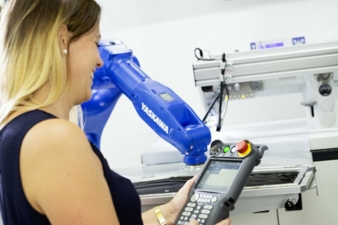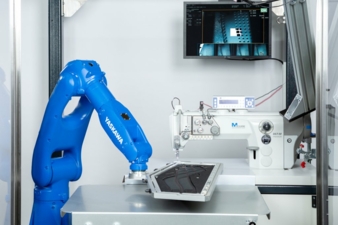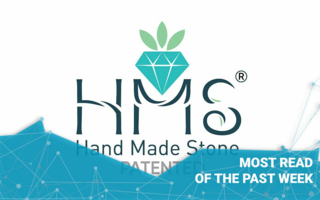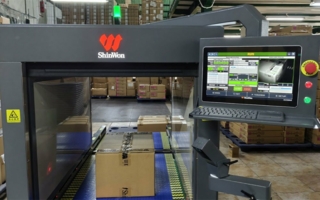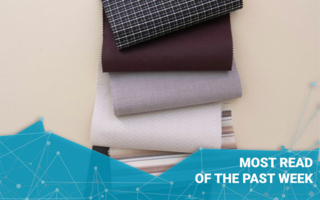03/12/2018 – Sewing robot — auf Deutsch lesen
The future of sewing!?
A renowned manufacturer of automatic sewing machines has introduced a six-axis robot for intricate sewing applications in automotive interiors.
KMF Maschinenbau GmbH in Schwäbisch-Gmünd has been specialising in the manufacture of automatic sewing machines since 1973. While the customer base at its start-up consisted mainly of clothing manufacturers, today most orders come from the automotive sector – and these are customers who demand top quality.
Dietmar Kuhn, plant manager at KMF, specifies the requirements: “When it comes to leather seat covers for premium vehicles, the parallel decorative stitching must be accurate to a tolerance of half a denier – and with a 0.4mm thick thread that means 0.2mm. That’s why these high-quality curved seams in parallel lines are virtually impossible to produce by hand.” Besides that, well-trained seamstresses who can cope with the stress of intense concentration in piece- and shiftwork are hard to find.
In order to comply with customer requirements for high quality appearance from the automotive industry there is a constant need for new, innovative solutions. Subject to the dictates of quality and cost-effectiveness, the experts at KMF see gigantic potential in robotics for providing process-reliable solutions. They have already acquired robotics experience in the automatic application of spray adhesives to upholstery and are using this know-how for the development of robot-aided sewing technology.
Need for fast and precise six-axis robots
The criteria of dynamism, range and precision played a decisive role in the selection of a suitable robot. Because the required tolerance on the finished part was 0.2mm and leather as a natural material is subject to variations, the company set about locating a six-axis robot with a repeatability that was better by about the power of ten. In addition, it was extremely important to KMF that the robot manufacturer should have a global network, as 75 percent of its automatic sewing machines are for export.
“Following an intensive market analysis we found the ideal combination in Yaskawa as a system partner and the Motoman GP7. With a repeatability of 0.03mm the robot is extremely accurate, its reach of almost one metre also fits the bill, and dynamically the six-axis robot can keep pace with our sewing machines,” stresses Kuhn. This robot forms the basis for the fully automatic RoQom 6000 sewing system, which also comprises a sewing machine, image processing system, safety SPS and corresponding templates in which the parts are secured.
Challenging tasks for market introduction
At the launch of the RoQom 6000 the automatic sewing cell was called upon to demonstrate its performance in a demanding application. The task set was to produce parallel curved seams on leather seat covers for vehicles in the premium segment. The extra effort involved with this decorative stitching is justified not only visual grounds – as Kuhn knows, it also performs an important comfort function: “Top-stitching causes three-dimensional deformation of the surface, which contributes to improved air circulation and in turn prevents the formation of sweat.”
With the robot sewing cell the automatic production of curved seams in lockstitch is fast, process-reliable and economical. Only the insertion and removal of the article in the template firmly mounted on the robot wrist is still manual. All further production steps are shared by the robot and sewing machine. The robot exactly follows the predetermined path of the seam in time with the sewing machine. With an accuracy of one tenth of a millimetre, the Motoman GP7 turns and tilts the article, factoring in the correction values of the stationary image processing in real time, in the course of which the tolerances of the natural material leather are compensated.
High-quality appearance
The articles that leave the plant have a high-quality appearance and are characterised by a degree of precision that would be impossible to achieve by manual work. “Those who are not familiar with our sewing robot will no doubt question the manufacturing process of these articles,” says Kuhn. In contrast, manual sewing processes are prone to error and require intensive quality checks.
With the combination of sewing robot and camera-aided tolerance compensation, RoQom 6000 rises to a new quality level. The automated process results in a significant reduction in the defect rate. Rejects of the expensive items are virtually eliminated, adherence to delivery deadlines is improved and much time is saved.
But reproducible quality and a high cost-efficiency of the process are only one side of the medal. Users from the automotive industry are particularly enthusiastic about the new freedom they gain with regard to intricate seam contours: “There are no bounds to the creativity of the designers when it comes to seam contours. This will have an impact on interiors in future, and permit even greater individualisation,” of that Kuhn is certain.
Besides the sewing of car seat covers, KMF has already received enquiries from the automotive industry for door panels for side trim and three-dimensional sewing on the dashboard.
Kuhn also sees a glowing future for robot-aided sewing in other areas, such as the sewing of filters and technical textiles: “This process offers unlimited potential. One of the enquiries recently received is for robot-sewn blankets for new-born babies.”
Industrie 4.0-compatible process
The use of robotics featuring state-of-the-art control technology finally creates the prerequisite for integrating sewing processes into Industrie 4.0 environments. For this purpose, the modular stand-alone cells can be simply incorporated into existing processes. RoQom 6000 systems are highly flexible when it comes to conversion to other product versions and plant extension. Individual cells thus can be extended step by step to complete production lines in which manual loading and removal of the article is replaced by automatic loading.
“To enable us to sew items with larger dimensions, we can easily replace the Motoman GP7 currently being used by Yaskawa six-axis robots with an ever greater reach. And if need be, we can use our big post-bed sewing machines for three-dimensional working. Under these conditions, we see considerable potential for the robot-aided process as a basis for the future of sewing,” says Kuhn.
Ralf Högel

